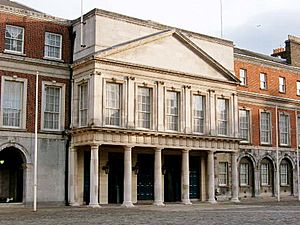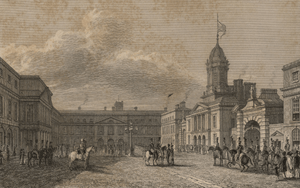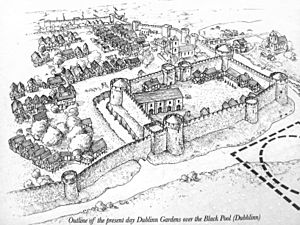Dublin Castle facts for kids
Quick facts for kids Dublin Castle |
|
|---|---|
|
Caisleán Bhaile Átha Cliath
|
|
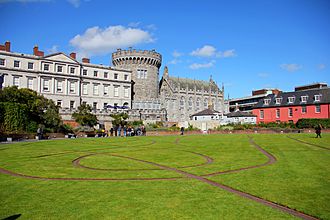
The Dubhlinn Gardens, which were completed in 1680, are located adjacent to Dublin Castle.
|
|
| General information | |
| Address | Dame Street |
| Town or city | Dublin |
| Country | Ireland |
| Coordinates | 53°20′34″N 6°16′03″W / 53.3429°N 6.2675°W |
| Elevation | 9 metres (30 ft) |
| Opened | 1204 |
| Owner | Ireland |
| Grounds | 44,000 square metres (11 acres) |
Dublin Castle (Irish: Caisleán Bhaile Átha Cliath) is a very important place in Dublin, Ireland. It's a big group of buildings used by the Irish government. It's also a place for meetings and a popular spot for tourists to visit.
The castle is located right in the middle of Dublin, near Dame Street. It was built on the highest point of central Dublin. For hundreds of years, until 1922, it was where the British government ruled Ireland from. Many of the buildings you see today were built in the 1700s. However, a castle has been on this spot since the time of King John, who was the first English Lord of Ireland.
Dublin Castle was the center of English, and later British, rule in Ireland for a very long time. This included the periods of the Lordship of Ireland (1171–1541), the Kingdom of Ireland (1541–1800), and the United Kingdom of Great Britain and Ireland (1801–1922).
After the Anglo-Irish Treaty was signed in December 1921, the castle was officially given to the new Irish government. This government was led by Michael Collins. Today, new Presidents of Ireland are officially sworn in here. The castle also hosts many important national events and welcomes leaders from other countries.
The castle got its name from a "dark pool" (called "Dubh Linn" in Irish) that was once nearby. This pool was part of the River Poddle before it joined the River Liffey. When the castle was first built, the Liffey was much wider. This meant the castle was naturally protected by both rivers. The River Poddle now flows underneath the castle complex.
Contents
What is Dublin Castle Used For?
Dublin Castle has been used for many different things throughout its history.
A Stronghold and Home
It was first built as a strong fort to protect the Norman city of Dublin. Later, it became the official home for the Lord Lieutenant of Ireland. This person was the King or Queen's representative in Ireland. The second most important person in the British government in Ireland, the Chief Secretary for Ireland, also had offices there.
Over time, the Irish parliament and some law courts met at the castle. They later moved to new buildings built just for them. The castle also served as a base for soldiers and, later, for intelligence services.
A Temporary Court and Presidential Home
When the Irish Free State was formed in December 1922, the castle temporarily became the home of the courts. This happened because the main legal building, the Four Courts, was badly damaged during the Irish Civil War. The courts stayed at the castle for ten years.
In 1938, it was decided that the first President of Ireland, Douglas Hyde, would be sworn in at the castle. Every President since then has had their inauguration ceremony there.
Hosting Important Events
The castle is also used to welcome leaders from other countries on official visits. It hosts important state dinners, like the one for Queen Elizabeth II in 2011. The Irish government also uses it to announce new plans and policies.
About every ten years, Ireland hosts the European Presidency. Dublin Castle becomes the main base for these important European meetings. Special conference centers, like The Hibernia Conference Centre and The Printworks, were built for these events in 1990 and 2013. These centers can also be rented by private companies.
Museums and Offices
The castle's State Apartments are now a museum. They hold many historical items. The castle complex also has a police unit (Garda Síochána) and the Garda Museum. Some government offices, like parts of the Office of Public Works and the Revenue Commissioners, are also located here. You can also find the Revenue Museum and the Chester Beatty Library within the castle grounds.
History of Dublin Castle
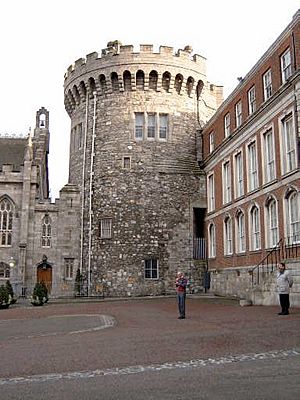
King John of England ordered Dublin Castle to be built in 1204. This was after the Norman invasion of Ireland in 1169. He wanted a strong castle with thick walls and good ditches. It was meant to defend the city, help with justice, and protect the King's money. It was the first main center for the English Crown in Ireland.
The castle was mostly finished by 1230. It was built in a typical Norman style, with a central square yard. It had tall defensive walls and round towers at each corner. The castle was located southeast of Norman Dublin. It formed one corner of the city's outer wall. The River Poddle helped protect two sides of the castle. The city wall connected directly to the castle's northeast Powder Tower. It then stretched north and west around the city, rejoining the castle at its southwest Bermingham Tower.
In January 1592, Red Hugh O'Donnell and two brothers, Art and Henry O'Neill, escaped from the castle. They had been held prisoner there. Henry O'Neill made it safely back to Ulster. O'Donnell and Art, with a guide, went south to Glenmalure. This was a place where rebels were safe. Art sadly died from the cold during this winter escape. This journey is remembered every January with the Art O'Neill Challenge endurance race.
In the 1600s, the castle was described as "the worst castle in the worst situation in Christendom" by the Earl of Arran.
The River Poddle was directed through arches in the city walls where they met the castle. This helped fill the castle's moat with water. You can still see one of these old arches and part of the wall buried under the 1700s buildings today. They are open for people to visit.
During the Middle Ages, the wooden buildings inside the castle square changed over time. A very important addition was the Great Hall, built from stone and wood. This hall was used as a parliament house, a court, and a place for big dinners. It lasted until 1673, when it was damaged by fire and then taken down.
The castle was badly damaged by a fire in 1684. After this, it was rebuilt and changed from a medieval fort into a grand Georgian palace. Today, you can't see any medieval buildings above ground, except for the great Record Tower. This tower was built around 1228-1230. It's the only original tower left from the first fort. Its top part was added in the early 1800s.
In 1764, a traveler named John Bush said the castle looked like "very little of grandeur" from the outside. But he noted that some of its rooms were "large and elegant."
United Irishmen General Joseph Holt, who took part in the Irish Rebellion of 1798, was held in the Bermingham Tower. He was later sent to Australia in 1799.
In 1907, the Irish Crown Jewels were stolen from the Castle. They have never been found.
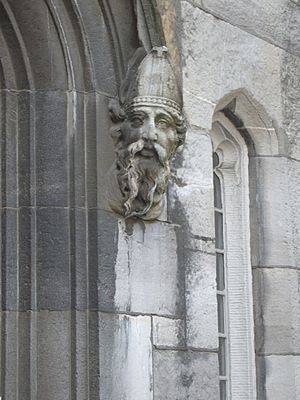
At the start of the Easter Rising in 1916, a small group of Irish Citizen Army members managed to take over the castle's entrance. But more soldiers for the castle's small guard soon arrived. During the Anglo-Irish War, the castle was the main center for the British against Irish independence fighters. On Bloody Sunday in 1920, three Irish Republican Army members, Dick McKee, Conor Clune, and Peadar Clancy, died there.
When the Irish Free State was formed in 1922, Dublin Castle stopped being the main government office. For some years, it was used as temporary courts. This was because the main court building, the Four Courts, had been destroyed. After the courts moved out, the castle was used for state events.
In the 1930s, Éamon de Valera, who was the leader of the Irish Free State, welcomed new ambassadors to Ireland at the castle. In 1938, Douglas Hyde became the first President of Ireland at the castle. All presidents since then have been sworn in there. The funerals of President Erskine Hamilton Childers in 1974 and former President Éamon de Valera in 1975 also took place there.
Buildings and Architecture
State Apartments
The State Apartments are in the southern part of the castle's Upper Yard. These rooms were once used by the Lord Lieutenant for living and for big parties. Today, these beautifully decorated rooms are used by the Irish government for official events. This includes welcoming leaders from other countries and the inauguration of the president every seven years. These apartments and their historical items are part of an official museum.
The main rooms in the State Apartments include:
- Saint Patrick's Hall
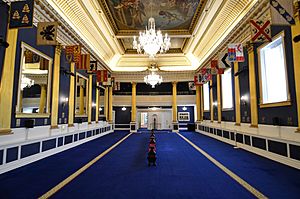
This is the grandest room in the State Apartments. It has one of the most important decorated ceilings in Ireland. It used to be the ballroom for the Lord Lieutenant. Today, it's where presidents are sworn in. If a president of Ireland dies while in office, like Erskine H. Childers in 1974, their body lies in state here.
This room is one of the oldest in the castle, built in the 1740s. Its decorations are mostly from around 1790. The ceiling has the most important painted artwork in Ireland, done by Vincenzo Valdre. It has three parts: one shows King George III being crowned, another shows Saint Patrick bringing Christianity to Ireland, and the third shows King Henry II meeting Irish leaders. The special dinner hosted by the President of Ireland for Queen Elizabeth II in 2011 was held here.
- Throne Room
This room was first built in the 1740s. It was changed into a special reception room around 1790. The royal decorations are from that time and from changes made in the 1830s. It has a throne made for King George IV when he visited Ireland in 1821.
- State Drawing Room
This room was redesigned in the 1830s. It was the main reception room for the Lord Lieutenant. Today, it's used to welcome important people from other countries. A fire in 1941 mostly destroyed it. The room was rebuilt between 1964 and 1968, using parts that were saved and new copies of old items.
- State Dining Room
This room is also called the Picture Gallery. It's the oldest room in the castle and still looks much like it did originally. It was built in the 1740s. It was meant to be a dining room next to St. Patrick's Hall. Today, it's still used for dining when conferences happen in St. Patrick's Hall.
- State Bedrooms
These rooms were once the private sleeping areas for the Lord Lieutenant. They were five rooms connected to each other. They were completely rebuilt in the 1960s after a fire in 1941. The rooms still follow their original layout. Today, they are used as extra meeting rooms for the main apartments. The last important person to stay in these royal bedrooms was Prime Minister Margaret Thatcher in the 1980s.
- State Corridor
This is a very grand hallway in the State Apartments. It was built around 1758. It has many arches and vaults. It was rebuilt in the 1960s after a fire. The corridor has exact copies of the original arch details. The original door frames and fireplaces were saved before the rebuilding.
Towers
Dublin Castle has towers at two of its corners. Other towers once stood within the complex.
- Bermingham Tower
The bottom part of the original Bermingham Tower is one of the few remaining pieces of the first castle. It's at the southwest corner of the castle. The top part of the tower is modern.
- Record Tower
The Record Tower is at the southeast corner and is another original part of the castle. It was built around the 1220s. It was fixed up between 1810 and 1813. It used to house the Garda Museum.
- Bedford Tower
Building of Bedford Tower started in 1750 and finished in 1761.
- Powder Tower
You can see the base of this tower in the basement of the northeast corner of the lower castle yard. It was built around 1228. Its walls were very thick, about 3.7 meters. The base of this tower is still along the path of the River Poddle. Old Viking defenses are still found under this part of the Castle.
- Cork Tower
This tower stood at the northwest corner of the medieval castle area. Its base remains behind the west side of the upper castle yard.
Government Offices at the Castle
The castle complex also holds some offices for the Revenue Commissioners, which handle taxes. This includes a Stamping Office in a building from the 1900s. This modern office building was designed in the late 1960s. Many groups did not like its design, saying it didn't fit with the old castle.
Some parts of the Office of Public Works (OPW) are in an old stables area. Some police functions (Garda Síochána) are also based at the Castle.
Visiting Dublin Castle
The castle buildings are usually open to the public. However, they close during certain state events. The crypt (underground room) of the Chapel Royal is now used as an arts center. Sometimes, concerts are held in the castle grounds.
The castle complex is also home to the Chester Beatty Library, which has its own special building and a café. You can also visit the Garda Museum and the Revenue Museum here.
The old "dark pool" area on the River Poddle has been turned into a garden. It has a water feature that remembers police officers who have died. There's also a sculpture and plaque nearby that honors the volunteers of the 2003 Special Olympics World Summer Games.
-
Panorama view. The upper yard of the Dublin Castle, Dublin, Ireland. The view shows, from left to right: Conference Centre, Bedford Hall flanked by the Gates of Fortitude and Justice, Revenue Commissioners, entranceway from the Chapel Royal/Record Tower yard, and finally States Apartments and Dubhlinn Tearooms.
How Dublin Castle is Managed
Dublin Castle is looked after and managed by the Office of Public Works (OPW).
Dublin Castle in Movies and Books
Film
Dublin Castle has appeared in several movies, including Barry Lyndon, Michael Collins, Becoming Jane, and The Medallion. It was also used in the TV series The Tudors, where it pretended to be the Vatican in the first episode.
Books
In George Moore's book A Drama in Muslin, Dublin Castle is shown as a place for fancy social events.
See also
 In Spanish: Castillo de Dublín para niños
In Spanish: Castillo de Dublín para niños



